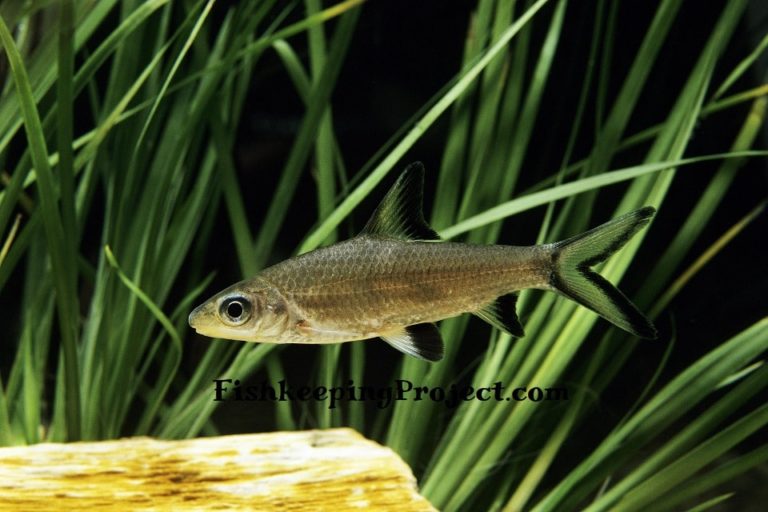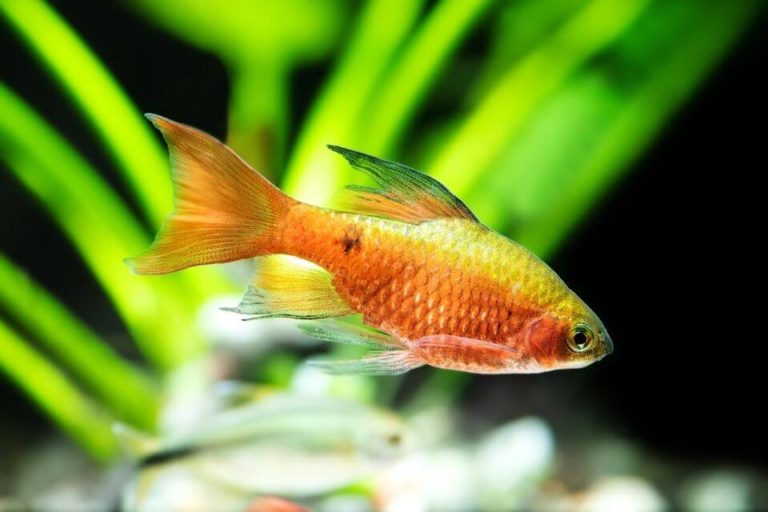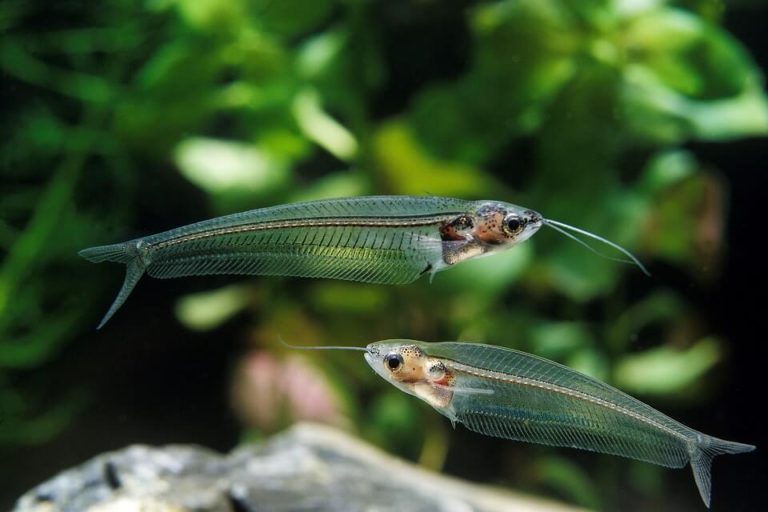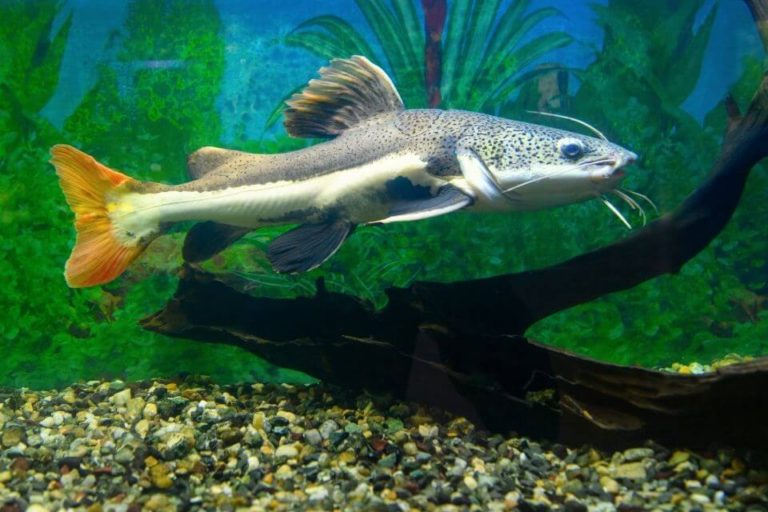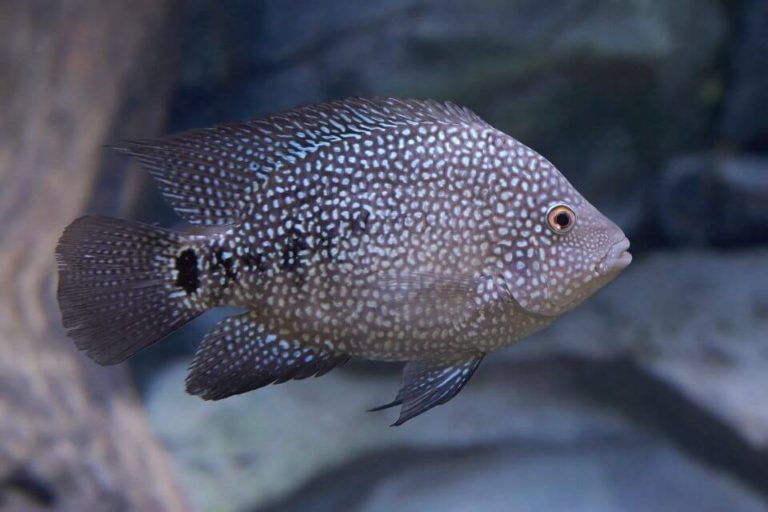Bamboo Shrimp Guide: AKA Wood Shrimp Caring, Tank Setup and Tank Mates
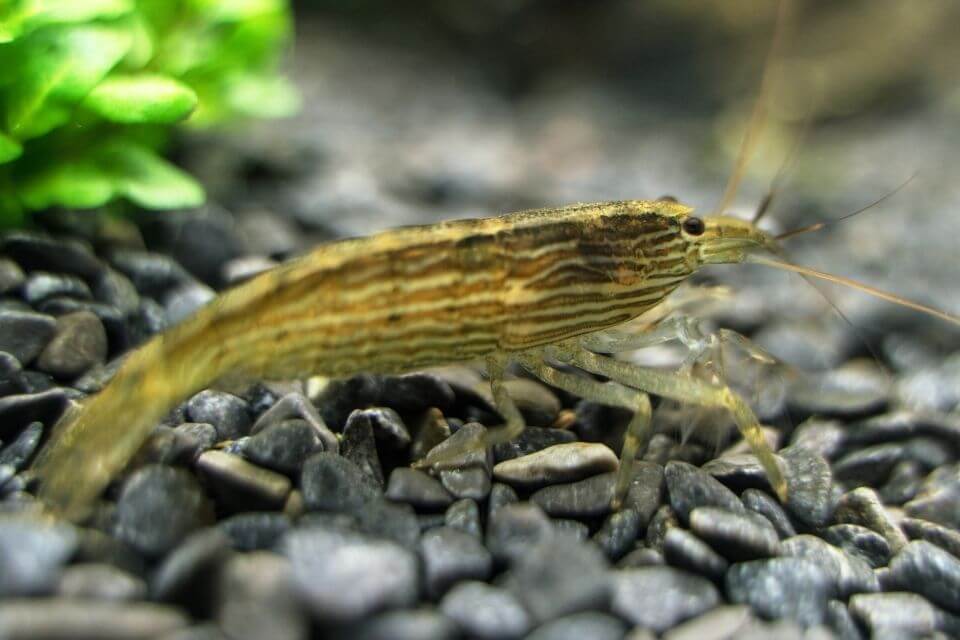
Bamboo Shrimp are gaining popularity worldwide as people find a way of adding life to their freshwater aquarium. These freshwater spices of South Asian origin are unique in behavior, characteristics, and colorfulness. Shrimp are mostly used in aquarium trades in the United States, Europe, and Asia.
Bamboo Shrimp easy to take care of and nowadays are readily available in all aquarium stores next to you. They are peaceful in moderate water currents and do not require urge tanks to sustain their lives.
If you need a friendly aquarium community, let dive into what makes Bamboo Shrimp unique and rewarding.
| Quick Facts: | |
|---|---|
| Common Names | : Bamboo Shrimp, Wood Shrimp, Singapore Shrimp, Flower Shrimp, and Asian Filter Shrimp |
| Scientific Name | : Atyopsis moluccensis |
| Family | : Atyidae |
| Origin | : Freshwater bodies of South Asia |
| Care Level | : Easy |
| Lifespan | : Up to 2 years |
| Size (average) | : 2 - 3 inches long |
| Diet | : Detritivores |
| Breeding | : Egglayer |
| Social | : Community |
| Temperament | : Peaceful |
| Minimum Tank Size | : 10 gallons |
| Temperature | : 72 - 82 °F (22 – 28 °C) |
| Water Hardness | : 2 - 10 dKH |
| Water pH Level | : 6.5 - 8 |
Overview of Bamboo Shrimp
These freshwater shrimp species belong to the Atyidae family and scientifically know as Atyopsis moluccensis. They are commonly known as Bamboo Shrimp and Wood Shrimp, but there are few other alternative names in the aquarium trade. Other alternative names are Singapore Shrimp, Flower Shrimp, and Asian Filter Shrimp.
They use a set of web-like fans to filter food from the water. They also possess a set of intricate antennae. At the base of the shrimp’s head, right next to the eyestalks, are the outermost antenna pair.
Base antennae are thick with a joint mechanism that allows them to bend, rotate and move freely. These antennae can grow very long to be seen sticking above the shrimp’s head.
Origin, Distribution, and Availability
These freshwater spices of South Asian origin are unique in behavior, characteristics, and colorfulness. Shrimp are mostly used in aquarium trades in the United States, Europe, and Asia.
Bamboo Shrimp easy to take care of and nowadays are readily available in all aquarium stores next to you. Also, finding them from online stores not that hard for convenient shopping.
Bamboo Shrimp Typical Behavior
At first, Bamboo Shrimp are very shy, but they adapt to boldness and infinitely calm creatures with time. Once they discover a favorable filter-feeding joint, they rarely move. As a result, algae may grow on their exoskeletons, do not panic. They are harmless to them. Bamboo shrimp are more active at night.
Having each Bamboo Shrimp alone won’t harm as long as it is provided with favorable conditions. Although they hardly interact amongst themselves, it is preferable to have them in groups to make them comfortable and less stressed. Always ensure their lid is covered, as Wood Shrimp jump out of the tank searching for another pond once stressed.
Another fascinating character of these creatures is their ability to acquire the best possible incoming water angle for feeding. Shrimp have been found to fall in love with porous surfaces or surfaces with nooks and crevices.
They usually place the little points on their legs’ edges on the pores and cracks before opening their fans for feeding. This feeding process works so effectively for them. Bamboo shrimps have no issues maintain the same position as long as the food supply is coming sufficiently.
Bamboo shrimp shell molting happens once every two months. They usually don’t feed on their molted shell as other breeds of shrimp do. Some fish keepers believe the molted shell will dissolve back into the water.
Characteristics of Bamboo Shrimp
Appearance
They possess two sharp eyes stalks on either side of the rostrum. The eyes are thick at the base. They are readily pulled in case of trouble arises. The carapace section has a long and thick diameter. It got a wood grain appearance with patterns across its length with six abdominal sections.
The sections are interlocked in a way to facilitate the abdomen to bend. The diameter narrows towards the tail. Although the wood shrimp have a flexible core, they mostly prefer to stay relative to streamline as they feed.
The legs are attached to the carapace, whereby the front legs are the strongest and longest. The back legs are usually thicker and shorter. The leg’s joints are systematic and unique, allowing for great flexibility and independence.
They have a squat body, strong legs, and short rostrum, which makes them plump and huge compared to the graceful dwarf shrimp species. The internal antennas are short and thick, which protrudes forward from the front head of the shrimp. Their movement is always back and forward.
Colors and Special Markings
Their color varies between red and brown. On some occasions, you might encounter green, orange, or yellow species of them. After molting, they all tend to acquire the brownish color despite their first color.
The tail comprises four think flat shell segments and telson, which can slide a bit. This segment makes it broader or more narrow; therefore, the rear can snap under the abdomen very fast, which results in the creation of a backward thrust to propel the shrimp backward as a defensive tactic.
Size of Bamboo Shrimp
These shrimp species are usually large compared to other freshwater shrimp species, They can grow up to an average of 3 inches. In some cases, they do grow to even over 4 inches when providing optimal tank conditions and extreme care.
Lifespan: How Long Do Bamboo Shrimp Live For?
Mostly, they have a lifespan of up to 2 years, although they do outlive the span with great care.
Aquarium Care and Conditions for Bamboo Shrimp
It is always fascinating to see Bamboo Shrimp in different places in your freshwater tank. Though they are most active in movement during the night, they change positions throughout the day and night. Covering the tank helps them from falling off the tank as they search for a better water flow angle to feed. They can last long after they are out of the tank; always maintain keen periodic checks to account for their safety.
Tank Conditions and Care
The aquarium will ever need mulch and residues for the shrimp to filter and feed. Whirl the water up from time to time is an essential process as it facilitates the particles to be caught by the shrimp’s fan. You should always perform partial water changes with care.
It isn’t a rear condition for bamboo shrimp to die after being added to tanked water. These may be as a result of shifts in parameters or stress as they were being transported. Once the bamboo shrimp dies, always ensure you remove it as soon as possible.
In a shared tank mate, mostly, the Amano shrimps and snails will begin to feed on the deed bamboo shrimp, although they will be interested in ingesting the shell rather than the body.
The threat to bamboo shrimp care is copper. Just like any other freshwater aquarium, it is necessary to avoid the discharge of copper content into the water. Also, ensure you carefully choose the plant fertilizers you are using. Once discharged into the substrate, plant fertilizers dissolve slowly hence becoming vital to them.
If the water is pushed around, the plant fertilizer gets stirred, releasing its content to the substrate column. Once consumed in large quantities by filter-feeding shrimps, they are always harmful. It would help if you ever searched for shrimp-safe plant fertilizer. Always take care not to dispose of a burst of fertilizers into the waters accidentally.
Tank Size
I recommend you to have a minimum of 10 gallons of a tank for your Bamboo Shrimp to be comfortable. But it is ideal that you accommodate them in a 20 or more gallons tank with other tank mates
To breed them you have to have an aquarium that holds at least 20 gallons of water to be the minimum requirements. A suitable pump is required to push the water around sufficiently, creating optimum currents. The tank should always be well cycled and rich in microorganisms as they need careful acclimation as any other shrimp.
Tank Setup
When considering the tank setup, the only special requirement for their survival is water current. Moderate water currents are required for their feeding. For example, a mitten filter is a perfect choice. In planted tanks, they tend to perform better. Not only do they benefit from hiding in the rocks, plants, and woods.

The ones with rocks, e.g., Lava, offer them the best posture to face water flow. Sponge filters on the powerful HOB power filter provide a conducive position for shrimps to position themselves as they intercept edible matter, which got stuck into the filter.
Also, large surface areas and organic particles are provided alongside the microflora and fauna they live in. The bigger the tank, the better as it keeps the water moving always. 20 gallons of deep water in a high tank may move too slow for the shrimp to feed on sufficiently.
Depending on the step-up, different lightings may be used. Most people prefer LED lighting as they are more affordable and available in the 21st century for the unplanted tank. The light should be on for a maximum of 8 hours a day to avoid excessive algae growth.
In a planted tank, lighting is more advanced. The lighting choice is based on CO2 concentration and fertilizer dosage. A bi-weekly water testing is required, with cycling ranging between 2 to 8 weeks. While cycling, heaters should always be set to maintain optimum temperatures.
In place of sufficient flow conditions in the aquarium, bamboo shrimps usually attach themselves in groups on the edge of large stones, roots, or any available rigid substrate. These species require a relatively long aquarium for sufficient uniform flow and volumes of water.
Suitable Plants
Shrimp prefer an aquarium with a lot of plants. Always ensure they are covered with freshwater plants. Such an aquarium provides the best places to hide, climb on, or even explore. Also, live plants provide more edible matters.
Planting Java moss, Water Wisteria, and Java fern would be ideal aquarium plants you can consider when setting up the tank for Bamboo Shrimp.
Water Condition, Temperature, and Parameters
Mostly, they are found on moderate to medium-hard water temperatures around 72 to 82 degrees Fahrenheit (22 to 28 degrees Celsius). However, it is preferred to maintain an optimum of 75 to 77 °F (24 – 25 °C). The water should always be kept clean but still contain adequate suspended solid to filter off.
You should always perform partial water changes with care. Ensure that the new dechlorinated water closely matches the water pond’s temperatures as shrimps seem sensitive to temperature fluctuations. Bamboo shrimp will require a massive aquarium due to their unique feeding behavior. Always ensure there is a consistent, sufficient oxygen supply in the tank.
- Water Temperature: 72 – 82 °F (22 – 28 °C)
- Acidity: 6.5 – 8 pH
- Hardness: 2 to 10 dKH
Bamboo Shrimp Diet and Feeding
The majority of them in-store aren’t well-fed, so when they are new to the pool, most likely, they will be extremely hungry or even starving. This will be normal to watch shrimp swimming to the bottom in search of edible matter. It is always recommended to feed bamboo shrimp on food rich in supplements.
It would be best if you worried as the situation is temporary, they will be back in line in a couple of days. In case your shrimp hides motion for an extended time, they are either preparing for molting or something wrong with them. It is more proven when the shrimp fails to molt and feed afterward.
If the situation persists, do not hesitate to check the water parameters and ensure everything is ordered.
It is fascinating to watch this giant invertebrate unique mode of feeding. Shrimp spread chelae in a filter-feeding manner in moving water, unfolding like an umbrella, until the adequate matter gets stuck into their fans. To resist the current, they hold tight on stones and roots.
They usually remain motionless in still water and do not sweep away substrate for food as most atyids do. Funny enough, no one has ever experienced bamboo shrimp making a burrow. Would you like to be the first one?
What Do Bamboo Shrimp Eat?
Sometimes, they feed on detrital particles. Bamboo shrimp use their fans to pick up substrates for food. This process should be avoided, as it is a sign of inadequate current or food in the current if it happens regularly.
Bamboo shrimp are detritivores. They mainly rely on drifting detrital elements by filtering the substrate. Usually traps microorganisms, organic detritus, and algae between their fans before transferring them to the mouth. Their food intake rate indirectly proportional to the current velocity.
That why they prefer high water velocity. Unlike other species of shrimp, Bamboo shrimps hardly exhibit omnivorous feeding habits.
Bamboo shrimp cannot feed on shrimp pellets; therefore, it is mandatory to be feed in powdered form to thrive. Like any other filter feeder, they require tiny particles of food that remain suspended in water for the longest time possible.
They can be feed on finely crushed food flakes, grounded food tablets, pond plankton, spirulina powder, etc. Oak and Almond leave greatly benefit bamboo shrimp, although they do not feed on them directly. Substances of these leaves improve the quality of water, making it easier for shrimp to molt. It is advisable to provide them with a complete diet rather than rotating different crushed foods.
In case you lack specialized shrimp food, you can alternatively feed them on fry sera micron, which is enriched with a lot of necessary nutrients and quickly drifts in water.
Supplement Bamboo shrimp food, which is very finely pulverized and softened, is used in a controlled amount. Few drops of the paste concoction are added to the upper stream current. The little particle contents land into the shrimp’s fans.
Be careful with the feeding as extra food can add excessive organic material to the tank resulting in bacterial bloom.
Feeding Routine for Bamboo Shrimp
Bamboo feeding occurs like a pattern. Feeding mostly takes place throughout the day. The food is filtered from the water current by what appears to be four fair baseball mitts holding up in front of the face.
After a couple of seconds, they move one of its gloves into the mouth and takes off bits of food. After observation, it seems it will look like a coordinated pattern by which they clean each of their mitts for a while.
For shrimp to acquire adequate food, it is essential to feed them at night. Sometimes, it is advisable to practice syringe feeding; uncontrollable spreading powder may lead to overfeeding.

Common Diseases of Bamboo Shrimp
Most of the diseases attacking bamboo shrimps are Repository disease. Such illness includes:
Vorticella:
This is an uncommon disease among the shrimps whose symptoms include a white fungus or mold growth on its shell. It is as a result of 16 known protozoa whose habitat is freshwater that mainly heterotrophic organisms whose prey is bacteria. Its reproduction mode is by binary fission.
Bacterial Infection
Although it is difficult to recognize, in transparent shrimp species, the organism infection is viewed internally. The infected shrimp tends to have a pink or appear inflamed instead of the dark translucent body. Signs and symptoms start to show between two to four days.
Parasites
Although many parasites live in a symbiotic relationship with shrimps, they sometimes are seen as wild.
Unlike in the dwarf species of the ornamented shrimp, it is elementary in bamboo shrimp to differentiate between a male and female shrimp.
Find A Bamboo Shrimp Male or Female
Firstly, the females are usually larger than the males. Despite the female being longer, they are also thicker. You can also look for the presence of a saddle. It is a small undeveloped and unfertilized egg building up in the female’s ovaries. It has a white appearance with a yellow dent.
The female shrimps usually have a more prominent and underbelly abdomen, whereas the males have a flat belly. The female second scale is roundly shaped while the male’s one is straight. Female pleopods are used for undercarriage, whereas the males use two of their pleopods for insemination.
With color, the male ones are more transparent than the female shrimps. Male antennas are more extended than female antennas. The best way to acknowledge a male or female bamboo shrimp is through the presence of a saddle. At two months old, their sex is usually clearly visible.
Bamboo Shrimp Breeding
Bamboo shrimps are so easy to keep but so hard for them to breed. For its larvae to survive, it requires brackish water, which doesn’t develop in freshwater. Once the egg is laid, it goes through multiple development stages before it converts to shrimp let.
On natural conditions, the larvae are pushed to lagoons by currents where it develops. The shrimp let then moves back to the freshwater after being hatched. Because the adult bamboo can withstand salty conditions, it becomes difficult and risky for the transfer and acclimatization of the larvae in salty conditions.
Even the artificial post larvae production attempts have been faced by variability in several larval stages, length of the development time, morphological changes, and other environmental requirements.
Bamboo Shrimp Tank Mates
In a condition where both Bamboo Shrimp and fish species share the tank, a lot of caution is observed in feeding. These giant bravos shrimp species tend not to fear small fishes, and therefore, when the particles are large, fish may bite them as they try to take it from their fans.
Never mix them with the Goldfish, Jack Dempsey, or any cichlids class fish because they will be feed on. The aquarium crayfish possess a threat to be shrimps tank mate as they can attack and feed on them.
Other breeds that can do well include;
- Vampire shrimp
- Amano shrimp
- Ghost shrimp
- Mystery snails
- Ivory snail
- Cory catfish
- Otocinclus catfish
- Rabbit snail
- Trumpet snail
- Ramshorn snail
Can Bamboo Shrimp Live with Cherry Shrimp?
Are you being concern about having a cherry shrimp as a bamboo shrimp tank mate? Both are nonaggressive shrimp with can coexist very peacefully in a conducive environment. None of them will hurt each other neither feed on the other despite the giant appearance of bamboo shrimp over cherry shrimp.
Interesting! Bamboo shrimp don’t tend to interact that much among themselves but seem very secure in crowds. Consult with the store manager before purchasing on the compatibility of the bamboo shrimps with other kinds of aquarium creatures. It is so interesting the way these shrimps get along with the different types of aquarium creatures.
It is always fantastic to watch the wood shrimp hang out with others of their kind with sufficient tank space. They show units as they bunch together in the case of excessive currents. If one gets too close to the other, they always squeeze themselves to deal with the situation. They never display any sign of aggression for individual territory, seem much happier when they all feed together for hours on end.
Are Bamboo Shrimp Aggressive?
Bamboo Shrimp are non-aggressive creatures with no claws or pincers to either defend or attack. While choosing a tank mate for them, ensure they belong to any community inhabitant, including medium-sized tropical fish.
Do Bamboo Shrimp Eat Other Shrimp?
If you are breeding bamboo shrimp with other shrimp breeders such as Amano shrimp in the same tank, it is advisable to keep a few Amano shrimp. This breeding is because Bamboo shrimp tend to consume planktonic larvae as they float by the stream.
Even though planktonic larvae are significantly giant, bamboo shrimp won’t feed on newly hatched Neocaridina and Caridina shrimp species.
Do Bamboo Shrimp Eat Plants and Algae?
Although Bamboo shrimp use trees for hiding, they can filter their content and feed on it indirectly. Content of finely crushed algae can be added to the current and becomes a massive source of supplements.
Conclusion
Bamboo Shrimp care isn’t difficult at all. The main challenge to face is ensuring the shrimp gets adequate food so they don’t starve. They are fascinating creatures who do not create a disturbance among other fish or their kind. You can’t keep your eyes away from them during mealtime because of their fan mode of feeding.



